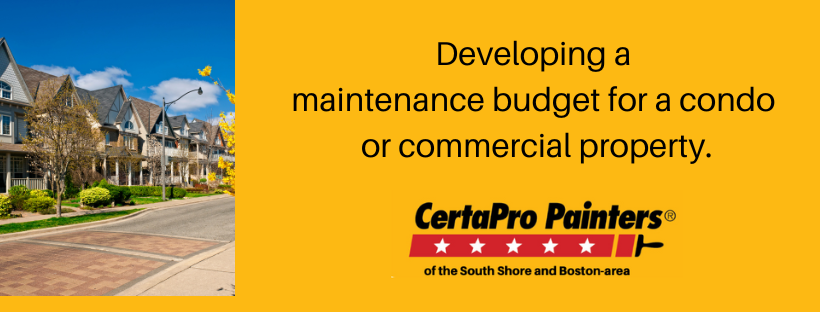
Developing a paint budget for Commercial Properties
Posted on August 2, 2022
How to develop a budget for a commercial painting project:
Property and facilities managers and building owners must budget for property maintenance, including painting. Here’s how we recommend you put together a budget for your property:
Regularly put money aside for community maintenance:
Routinely putting money aside for commercial projects, including painting, is essential, so maintenance expenses don’t surprise you. If the painting and the air conditioning units need to be handled simultaneously, you know it ahead of time and have the money to pay for both. Having these conversations allows you and your team to be prepared, budgeted, and financially solvent when projects arise.
An easy way to think about it is like condominium maintenance fees – set aside monthly money for your property to cover routine expenses like painting, snow removal, plumbing, roofing, and electrical. If you meet with contractors in all of these disciplines, you’ll have an idea of how often you’ll need their services (this is called a “maintenance cycle”) and how much those services cost.
Develop relationships with contractors.
If you have an ongoing relationship with a painting contractor who knows your property, calling them puts you at the top of their list when you need them. “It takes a village” to run a commercial property, so make sure the contractors in your village are ones you trust and can depend upon.
Once you know your budget and the maintenance and timing needs of your commercial property, you can begin by getting quotes. If you’re unsure what to include when putting your request for proposal (RFP) together, our Commercial Team has the expertise you need. We can help you build the necessary scope for the quoting process that you give other painting contractors when quoting the project.
Meet with painting experts.
 Meeting with a commercial painting contractor will give you a predictable idea of the projects you need to consider to keep your property looking great and protected from the harsh New England elements.
Meeting with a commercial painting contractor will give you a predictable idea of the projects you need to consider to keep your property looking great and protected from the harsh New England elements.
For example, knowing that the trim on a condominium complex will need painting in about two years lets you start putting money away for that project now.
Develop an RFP for your painting project.
Once you have identified painting and carpentry projects that need to be rebid, it is a great idea to create formal “request for proposals” (RFPs) to send to vendors.
Here are RFP instructions and a Microsoft Word template to start you off.
Get at least three bids on most projects, even though there will be times when fewer or more than three bids are necessary. Request bids from your “old standby” contractors and contractors you may use less frequently. Getting painting and carpentry bids from new and multiple contractors results in more competitive pricing and better service. Contractors can become complacent and less competitive on pricing when contracts are not continually reanalyzed. Property managers have an ethical duty to obtain the best painting and carpentry services at the best prices for both the property owner and tenants because budget expenses are often passed through to tenants.
When drafting an RFP, be very clear about the materials and quality level of the painting you’re expecting. Where possible, use industry-standard language so everyone bidding on the RFP is on the same page. Include your timeframes, particularly if the projects inconvenience the owners or tenants.
Compare potential painting contractors and their prices.
After receiving all painting quotes, compare potential painting contractors and their prices. List the specific differences between each commercial painting contractor, including their professionalism, processes, and prices. This will give you the pros and cons list to help determine which commercial painter seems best for your projects.
If you notice that the quotes you received are not within the budget you discussed, this is a red flag that the company was not listening to your needs or that your budget is unrealistic for the scope of work needed.
Come up with a Painting Maintenance Plan:
While painting plans are highly individualized based on the exact materials of your building, you can start with the following paint items that you’ll likely need for maintenance every now and then:
- Powerwashing
- Mold and mildew cleaning and removal
- Interior painting – especially in high-traffic areas that get scuffed easily (think lobbies, restrooms, cafeterias, gyms)
- Exterior painting to protect the outside of your property
- Wood replacement in areas you can see wood rot
- Wood inspection for a closer look at higher places where wood rot is forming, but not easily seen from the ground
- Painting to railings, decks and fire escapes
Understand the property’s past needs:
 Pulling out some of the actual pricing from past projects may be a good idea. This will give you a good idea of two things:
Pulling out some of the actual pricing from past projects may be a good idea. This will give you a good idea of two things:
- How often do you need to perform that type of painting maintenance? For example, you may decide that painting the building’s trim every seven years is a good action plan.
- The approximate pricing to perform the painting. Look at old quotes or loop us in to get today’s pricing.
Make sure the painting quote is detailed, specific, and contains photos:
The following details should be on your painting quote to ensure you won’t be hit with expensive change orders and add-ons while the project is in progress:
- Every specific detail of work to be done should be written in a language you understand, including every surface that will be painted or repaired
- Exactly how each surface will be prepared (sanding, washing, priming, etc.)
- What types of products will be used, and where? You need the brand and grade of paint listed on the quote, so you know you’re not receiving the cheapest grade of paint a brand offers.
- Photos with captions describing the work to be completed in this area – so both you and the estimator are on the same page are the single most important part of the quote because they clarify the project’s scope for everyone.
- The contractor’s insurance certificate. See if they’ll add you as an “additional insured” for extra protection. Most commercial painters should be able to provide this before you even hire them.
- The payment schedule – most commercial painters will ask for a 25% deposit, and then for large jobs, progress payments as the job progresses.
Create a contingency fund:
- Unexpected issues can arise during a painting project, so it is a good idea to set aside a contingency fund in case additional work is needed. This could include repairing any damage discovered during the painting process or changes to the original scope of work.
Need a painting partner for your commercial property?
We consult on Boston area commercial projects and would be happy to discuss your needs and help you create a painting maintenance plan.
Email Dave Rowell at [email protected] or call us at 781-422-1018.
< BACK TO OUR INDEX OF ARTICLES, TIPS, AND ADVICE
You might also find these commercial painting resources useful:
Our ultimate “Commercial Painting for Rookies” guide
Specifying elastomeric paint for stucco and concrete block buildings
How to check the licenses and insurance on a commercial painter (and why it matters)






